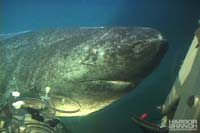Startling deep-sea encounter with rare, massive Greenland shark

Huge Greenland shark as it approaches Harbor Branch’s Johnson-Sea-Link submersible <br>Credit: HARBOR BRANCH/Youngbluth
During a recent submersible dive 3,000 feet down in the Gulf of Maine a HARBOR BRANCH scientist and sub pilot had the first face-to-face meeting ever in the deep sea with a rare Greenland shark. The docile 15-foot creature gently rammed into the submersible’s clear front sphere before turning and swimming slowly away. The entire encounter was captured on video, a clip of which can be viewed by clicking under the shark’s photo at: http://www.at-sea.org/missions/maineevent4/day14.html
HARBOR BRANCH researcher Marsh Youngbluth and his team were in the region studying a large jellyfish known as Nanomia cara, which can cause commercial fish catch declines by out-competing fish larvae for certain foods and by filling and fouling fish nets. He and submersible pilot Tim Askew, Jr. were startled by the huge shark’s appearance and feared at first that it might damage the submersible or its scientific sampling equipment, though no harm was done. After the shark swam away from the submersible Askew followed it for several minutes.
Though in the early 1900s Greenland sharks were fished commercially, they have rarely been captured on video and never before from a manned submersible in the deep sea or under natural conditions. All past filming encounters involved sharks lured with bait or captured on fishing lines and brought near the surface.
Greenland sharks, also called sleeper or gurry sharks, have been known to grow as long as 21 feet, and are outsized only by great white, basking, and whale sharks. Greenland sharks are poorly understood but known for their lethargic swimming and a unique fishing technique. Small marine crustaceans known as copepods generally attach themselves to the sharks’ eyes (and are visible in the new footage), possibly blinding them, but giving off light that attracts curious fish.
It is not clear how the sluggish animals are able to catch the fast-moving fish and squid commonly found in their stomachs. Some scientists have theorized that the sharks are able to swim rapidly in bursts, but there is also evidence that they are able to suck nearby fish into their mouths. During the Gulf of Maine encounter, even after ramming into HARBOR BRANCH’s submersible, the shark continued to swim slowly. Greenland sharks also eat seals, dead whales, and other animals, including in at least one documented case, an entire reindeer. They are typically found in Arctic waters at depths down to 1,800 feet, but have been recorded as far south as the coast of South Carolina and at nearly 7,000 feet down.
###
For more information please contact Mark Schrope at 772-216-0390 or schrope@hboi.edu. Photos and video of the shark encounter, which took place Sept. 25, are available to illustrate stories about HARBOR BRANCH, and can be licensed for other uses.
Media Contact
All latest news from the category: Life Sciences and Chemistry
Articles and reports from the Life Sciences and chemistry area deal with applied and basic research into modern biology, chemistry and human medicine.
Valuable information can be found on a range of life sciences fields including bacteriology, biochemistry, bionics, bioinformatics, biophysics, biotechnology, genetics, geobotany, human biology, marine biology, microbiology, molecular biology, cellular biology, zoology, bioinorganic chemistry, microchemistry and environmental chemistry.
Newest articles

Bringing bio-inspired robots to life
Nebraska researcher Eric Markvicka gets NSF CAREER Award to pursue manufacture of novel materials for soft robotics and stretchable electronics. Engineers are increasingly eager to develop robots that mimic the…

Bella moths use poison to attract mates
Scientists are closer to finding out how. Pyrrolizidine alkaloids are as bitter and toxic as they are hard to pronounce. They’re produced by several different types of plants and are…

AI tool creates ‘synthetic’ images of cells
…for enhanced microscopy analysis. Observing individual cells through microscopes can reveal a range of important cell biological phenomena that frequently play a role in human diseases, but the process of…





















